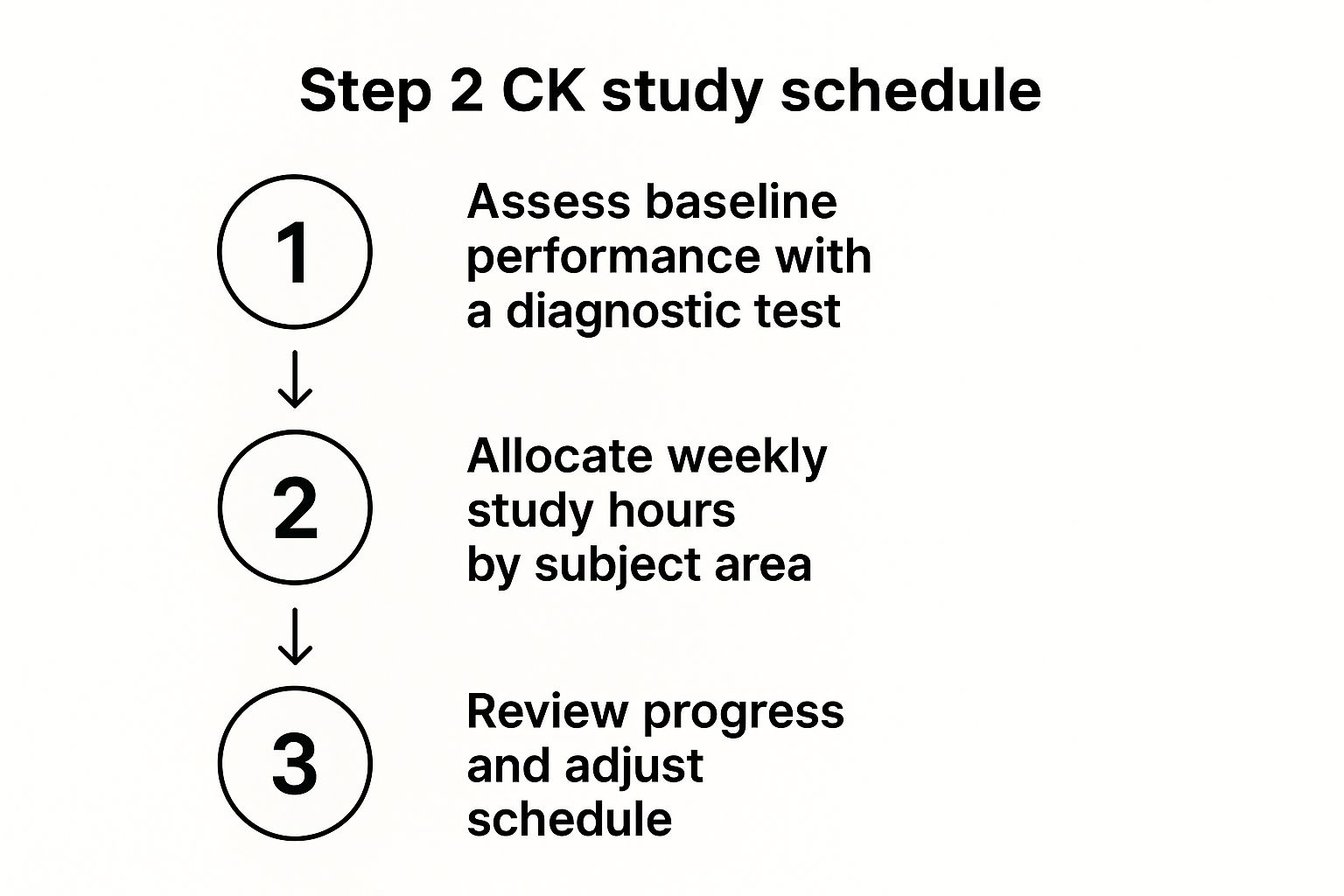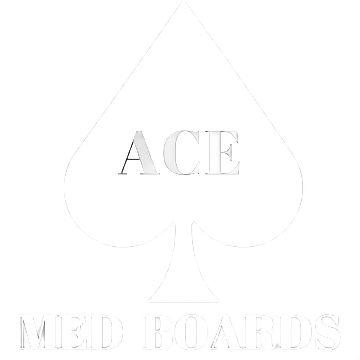Let’s get one thing straight right from the start: your USMLE Step 2 CK score is the new king of your residency application. With Step 1 now pass/fail, this exam isn’t just another hurdle—it’s the definitive academic benchmark that program directors are scrutinizing.
This shift isn't a small tweak; it's a seismic change. Understanding this reality is the first, most critical step in building a step 2 ck study plan that actually gets you where you want to go.
Why Your Step 2 CK Score Is Your New Priority
Remember when that three-digit Step 1 score was everything? Program directors could use it as a quick, easy filter to sort through thousands of ERAS applications. Well, those days are over.
Now, that intense focus has shifted squarely onto the next objective, standardized number they have: your Step 2 CK score. A strong performance here is no longer a nice "bonus" to round out your application. It’s now the primary academic gatekeeper for many programs, determining who gets a serious look and who gets moved to the "maybe" (or "no") pile.
The Data Doesn't Lie
This isn't just a hunch; the evidence is overwhelming. After Step 1 went pass/fail, a major survey of residency program directors revealed a staggering statistic: 81% now consider Step 2 CK scores more important when deciding who to interview.
Think about that for a second. More than four out of five program directors have explicitly said this score now carries more weight. You can dig into the full report to see just how dramatically the landscape has changed, but the message is crystal clear. Your score is your new first impression. It can open doors to competitive specialties or slam them shut before anyone even glances at your personal statement.
Key Takeaway: Your Step 2 CK score is now the single most important objective academic data point on your residency application. It's the first filter for your clinical knowledge and test-taking skills, directly impacting your chances of landing an interview.
What This Means For Your Study Strategy
Realizing this is your lightbulb moment. Your prep can’t be a last-minute scramble or a casual review. It demands a deliberate, long-term strategy that starts well before you even think about your dedicated study period.
A high score tells programs much more than just "I know my stuff." It signals that you have the clinical reasoning, the work ethic, and the ability to perform under pressure—all core competencies they are desperately looking for in a future resident. Your score is a direct reflection of your ability to synthesize and apply a massive amount of clinical knowledge.
So, building a bulletproof step 2 ck study plan isn't just about passing. It's about strategically positioning yourself to be a top-tier candidate in a field that's more competitive than ever.
Laying the Groundwork: How to Use Your Clerkships to Build a High-Yield Step 2 CK Foundation

Let’s be real. A top-tier Step 2 CK score doesn’t magically appear after a few frantic weeks of dedicated studying. It’s earned, month by month, during your third-year clerkships. The students who crush this exam are the ones who treat their clerkship year as a "slow burn" prep period, building a rock-solid base that makes their dedicated study time infinitely more productive.
The trick is a simple mindset shift. Stop seeing each shelf exam as just another hurdle to clear. Instead, view it as a dress rehearsal—and a diagnostic tool—for a specific slice of Step 2 CK. Performing well on your shelves has a direct, proven correlation with a higher Step 2 score, so you're essentially knocking out two birds with one stone.
Start Your First Pass of UWorld from Day One
Waiting until your dedicated period to crack open UWorld is one of the most common—and costly—mistakes I see students make. A much smarter approach is to begin your first pass of the question bank the moment your first clerkship begins. The goal here isn't about speed or nailing a high percentage. It's about deep conceptual learning.
Here’s how to do it right:
- Align Questions with Rotations: On your pediatrics rotation? Do the peds questions. On surgery? You guessed it—do the surgery questions. This strategy is brilliant because it directly reinforces what you’re seeing on the wards and preps you for your shelf exam at the same time.
- Embrace Tutor Mode: Early on, Tutor Mode is your absolute best friend. It gives you instant feedback and detailed explanations right after you answer, which is exactly what you need to build your knowledge from the ground up.
- Get Obsessed with the "Why": Don't just gloss over the explanation. For every single question, whether you got it right or wrong, force yourself to understand why the correct answer is right and, just as critically, why every other option is wrong. This is how you build the clinical reasoning muscle that Step 2 CK tests so heavily.
This slow-and-steady method keeps you from facing the terrifying prospect of 3,000+ questions in a few short weeks. By the time dedicated rolls around, you'll have already completed a full pass. Your focus then shifts from initial learning to true mastery and score optimization.
Pick Your Core Resources and Stick with Them
Consistency is everything. It's so tempting to jump between a dozen different resources, but this "resource FOMO" will only dilute your efforts. At the start of your third year, choose a few high-quality tools and commit to them.
Your toolkit should be simple but powerful:
- A Core Question Bank: For almost everyone, this means UWorld. It's the undisputed gold standard for a reason.
- A Content Review Source: This could be a video platform like OnlineMedEd or a book series. Use this to fill in the gaps when UWorld explanations aren't quite clicking.
- An Anki Deck: Whether you use a pre-made deck like AnKing or make your own cards from incorrect UWorld concepts, spaced repetition is non-negotiable for long-term retention.
Committing to a few trusted resources throughout your clerkships creates a cohesive, integrated learning system. You're not wasting time trying to figure out a new resource's style; you're building a deep, interconnected web of knowledge—the exact kind you need for a successful step 2 ck study plan.
By treating your clerkship year as Phase 1 of your Step 2 CK prep, you're doing more than just studying; you're building habits. You learn how to squeeze question review into a packed clinical schedule, turning small, consistent efforts into a massive head start. This approach transforms the dedicated period from a stressful cram-fest into what it should be: a final, confident push toward your goal score.
Crafting Your Dedicated Study Schedule
Your dedicated study period is the final, high-intensity push before the exam. This is where all the groundwork from your clerkships comes together, transforming your knowledge base into a peak performance on test day.
Forget those rigid, one-size-fits-all schedules. The best step 2 ck study plan is one that’s built around you—your energy levels, your learning style, and most critically, your specific weaknesses.
Whether you have four weeks or six, the core principles don't change. You need a balanced mix of new questions, in-depth review, targeted deep dives into weak areas, and scheduled rest. A sustainable routine is your greatest asset here; it's the key to preventing the burnout that can derail even the most well-prepared students.
Choosing Your Timeline: 4 vs 6 Weeks
The first big decision is your timeline. How long should your dedicated period actually be? This depends almost entirely on the effort you put in during your clinical rotations.
The 4-Week Plan: This timeline is perfect if you were consistent with UWorld during your clerkships and performed well on your shelf exams. Think of it as an intense, focused sprint designed for sharpening your test-taking strategy and cementing knowledge, not for learning core concepts from scratch.
The 6-Week Plan: If your studying during rotations was a bit spotty, or if you have known, significant weak areas, those extra two weeks are a godsend. A six-week schedule allows for a less frantic pace, giving you more breathing room for deep content review and maybe even a second pass of your UWorld incorrects without having to sacrifice your well-being.
This image breaks down the core process of building your schedule, no matter which timeline you choose.

The key takeaway? A great plan isn't static. It starts with a solid baseline assessment and then adapts continuously based on the data you get from your practice questions and self-assessments.
Designing Your Ideal Study Day
One of the most common mistakes I see students make is trying to study for 12-14 hours straight. This is a fast track to burnout and diminishing returns. A much more effective approach is to structure your day into focused blocks that mimic the exam itself, with plenty of built-in time for review and recovery.
Your day should revolve around doing question blocks and—more importantly—reviewing them. A solid starting point is 2-3 UWorld blocks (80-120 questions) per day. But the real learning doesn't happen when you're answering the questions; it happens in the review.
Pro Tip: Your review of a 40-question block should take at least twice as long as it took to complete it. If you finished the block in 60 minutes, you should be spending at least two hours picking apart every single question, right and wrong.
A Sample Daily Framework
Think of the following schedule as a flexible template, not a strict set of rules. You need to adjust it to fit your personal rhythm. If you're a night owl, just flip the schedule. The goal is consistency, not conformity.
Here’s a look at what a balanced day might look like during a 4-week dedicated period.
Sample 4-Week Dedicated Step 2 CK Daily Schedule
| Time Block | Activity | Notes & Tips |
|---|---|---|
| 8:00 AM – 9:00 AM | UWorld Block 1 (40q, Timed) | Tackle this first thing while your mind is fresh. Use strictly timed mode to build stamina. |
| 9:00 AM – 11:30 AM | Review Block 1 | This is the most crucial part of your day. Make flashcards (Anki!) for every single incorrect. |
| 11:30 AM – 1:00 PM | Lunch & Break | Completely disconnect. Get outside, exercise, or do something you actually enjoy. No screens. |
| 1:00 PM – 2:00 PM | UWorld Block 2 (40q, Timed) | Fight that post-lunch slump by diving straight into your second block. |
| 2:00 PM – 4:30 PM | Review Block 2 | Focus on understanding why the wrong answers were wrong. Look for patterns in your errors. |
| 4:30 PM – 6:00 PM | Targeted Content Review | Address the weak topics you identified from today's blocks. Use videos or review books for this. |
| 6:00 PM – 7:00 PM | Dinner Break | Step away from the books. You've earned it. |
| 7:00 PM – 8:00 PM | Light Review / Anki | Do your daily Anki reviews. This is active recall, not passive reading before bed. |
| 8:00 PM onwards | Protected Rest Time | Your brain needs time to consolidate information. Prioritize sleep and true relaxation. |
This structure dedicates roughly 8-9 hours to active studying, which is a rigorous but sustainable pace for the dedicated period.
Making Your Review Process High-Yield
Just reading the UWorld explanations isn't going to cut it. You need an active system to process your mistakes and turn those weaknesses into strengths.
- Create a Mistake Journal: For every question you miss, log the topic, why you got it wrong (e.g., knowledge gap, misread the stem), and the key learning point in your own words.
- Master Your Flashcards: Use a tool like Anki to create cards for every concept you missed or felt shaky on. Daily review of these is non-negotiable for long-term retention.
- Simulate Test Day: At least once a week, you need to build your endurance. String together 8-9 blocks to simulate the full, grueling 9-hour exam experience. This builds the mental and physical stamina you'll need.
By adopting this methodical and adaptable approach, your dedicated period becomes a focused, high-yield machine. For a deeper dive into study methodologies, you can also explore our guide on how to study for USMLE Step 2. This is how you turn your step 2 ck study plan from a simple to-do list into a dynamic tool for achieving your peak performance.
Selecting and Mastering High-Yield Resources

The market is flooded with shiny new resources for Step 2 CK, and it's incredibly easy to fall into the trap of thinking you need to use all of them. Let's be real—success comes from mastering a select few high-quality tools, not from casually flipping through a dozen. A focused approach is your best defense against information overload and ensures you actually learn the material, not just see it.
The bedrock of any solid step 2 ck study plan is picking your core resources and committing to them. Quality over quantity isn't just a cliché here; it's the entire game.
Maximizing the Gold Standard: UWorld
It's no secret that UWorld is the cornerstone of Step 2 CK prep. But here’s something I see all the time: students just blaze through the questions to say they "finished" it. The real, score-boosting value comes from how you use this powerhouse Qbank. Think of it as your personal diagnostic tool, not a checklist.
A common debate I hear is tutor mode versus timed mode. The most effective strategy I've seen is a hybrid approach. Early on, tutor mode is fantastic for building a strong knowledge base with that instant feedback loop. But as you transition into your dedicated study period, you absolutely must shift to primarily timed, random blocks of 40 questions. This is non-negotiable for simulating test-day conditions and building mental stamina.
Key Insight: The goal isn't just to do UWorld; it's to master it. Plan to spend more time reviewing your blocks—both your correct and incorrect answers—than you spend actually doing them. This deep, analytical dive is where the real learning and score jumps happen.
Layering Your Supplemental Resources
While UWorld is the sun in your study solar system, layering in one or two other key resources can fill knowledge gaps and show you concepts from a different angle. The crucial part? Don't overdo it. You're trying to build a streamlined, effective toolkit, not a library of untouched books and pricey, unused subscriptions.
Here’s how to strategically add a couple of other top-tier resources into your flow:
- Amboss: This is an incredible tool to use alongside UWorld. Its library is so comprehensive it functions like an interactive, searchable medical encyclopedia. When a UWorld explanation doesn't quite land, popping the topic into the Amboss library often provides that extra layer of clarity and detail you need. Their "highlighting" feature, which points you to the most critical info in a question stem, is also a game-changer for honing your diagnostic eye.
- OnlineMedEd (OME): If you're a visual or auditory learner, OME is pure gold for building a solid conceptual framework. Dr. Williams has a gift for breaking down ridiculously complex topics into digestible, memorable videos. I always recommend students use OME for subjects where they feel particularly weak to build a foundation before they start getting slammed with questions on it.
- Anki: Spaced repetition is the secret sauce for long-term retention. You simply can't afford to skip it. Whether you use a pre-made deck like AnKing or build your own cards from your UWorld incorrects, daily Anki review is essential. This active recall process is what cements information in your long-term memory. For more ideas on what to use, you can check out our curated list of the best books for Step 2 CK.
Understanding the Scoring Landscape
Knowing your resource strategy is one thing, but you also need to know the target you're aiming for. Statistics from the 2023-2024 cycle show the mean Step 2 CK score was around 249, with roughly 50% of everyone scoring between 231 and 260.
Just aiming for "average" isn't a winning strategy, especially if you have your sights set on a competitive specialty. For a deeper dive into score distributions, you can always review the official performance data from the USMLE.
Ultimately, your resources should create a cohesive system. Use UWorld to test and diagnose, Anki to retain, and Amboss or OME to clarify. By mastering a few tools instead of juggling many, you create a powerful, efficient, and far less stressful study plan that drives real results.
Using Assessments to Guide Your Final Push

As you head into the final weeks of your dedicated period, it's time to shift gears. The broad, foundational content review got you here, but now it's all about a hyper-focused, data-driven attack. Your self-assessments—the NBMEs and UWorld Self-Assessments (UWSAs)—are no longer just progress checks. They are your personal GPS for this final push.
Think of each practice test as a deep diagnostic tool. The three-digit score is just the headline; the real gold is buried in the performance analytics. This data tells you exactly where your weaknesses are hiding, allowing you to fine-tune your study plan with surgical precision.
Creating a Strategic Assessment Timeline
Randomly taking practice tests is a classic way to waste time and opportunity. To get the most predictive and useful data, you need to space them out strategically. A smart timeline lets you assess, adjust your studying, and then reassess your progress to see if your changes actually worked.
For a typical 4-week dedicated period, here’s a timeline that I’ve seen work wonders for students:
- End of Week 1: Take your first practice exam (an older NBME form is perfect for this). This gives you a baseline score and your first big dataset to find any glaring weak spots.
- End of Week 2: Take another assessment, like UWSA 1. Use this to see if the adjustments you made after the first test are paying off and to identify the next layer of topics to hit hard.
- End of Week 3: Now, take a newer NBME form. These are often considered highly representative of the current exam's question style and feel.
- 3-5 Days Before Exam Day: Take UWSA 2 and/or the Free 120. These are widely seen as the most predictive assessments of your final score and serve as a final confidence booster.
This structured approach turns your studying from a guessing game into a targeted mission. If you want a more detailed breakdown, you can check out our guide on creating a USMLE Step 2 CK study schedule.
Beyond the Three-Digit Score
Getting the score is easy. The hard part—and the most important—is interpreting it correctly. You have to move past that initial emotional reaction to the number and become a detective, hunting for patterns in your performance.
The biggest score jumps in the final weeks come from a ruthless, honest analysis of your mistakes. It’s not about how many you missed, but why you missed them. This is the key to unlocking those last, crucial points.
When you sit down to review your assessment, ask yourself these questions:
- System-Specific Weaknesses: Are you consistently scoring lower in one area, like cardiology or psychiatry? The data will show you.
- Question Type Issues: Do you get tripped up on "next best step" questions, ethics, or those super long, convoluted stems?
- Knowledge vs. Reasoning Errors: Are you getting questions wrong because you genuinely didn't know the fact? Or did you misinterpret the question or fall for a well-laid trap?
Answering these gives you a clear, actionable to-do list. If biostats is a recurring problem, you know you need to carve out a few hours to master it. If timing is killing your score, you need to practice more timed blocks, period.
This data-driven approach also grounds your goals in reality. For example, if you're aiming for a hyper-competitive specialty like plastics or dermatology, you know you need to push for scores above 250. On the other hand, specialties like family medicine often report median scores closer to 230. Knowing this context helps you interpret your practice scores and set a realistic target.
By using your assessments as a guide, you make sure every single hour you spend in these final weeks is high-yield. You stop wasting time on subjects you've already mastered and pour all your energy into the precise areas that will make the biggest difference on exam day.
Of course. Here is the rewritten section, crafted to sound like it was written by an experienced human expert, following all the provided guidelines and examples.
Your Top Step 2 CK Prep Questions, Answered
As you gear up for the final stretch of your USMLE Step 2 CK prep, it's completely normal for a flood of questions and "what-ifs" to surface. Everyone goes through it. Having a clear, experience-backed answer to these common concerns will keep you grounded and prevent you from second-guessing your Step 2 CK study plan.
Let's cut through the noise and tackle the most pressing questions I hear from students all the time.
How Long Should My Dedicated Study Period Be?
This is probably the most common question I get, and the honest answer is: it depends entirely on how you performed during your clerkships. For most students, the sweet spot is a 4 to 6-week dedicated timeline.
A four-week schedule is really an intense sprint. It's best suited for students who were on top of their UWorld questions all through third year and felt pretty solid about their shelf exam scores. Think of it as a sharpening phase to hone your test-taking instincts and hammer in those high-yield facts, assuming your foundation is already strong.
On the other hand, a six-week schedule offers a crucial bit of breathing room. If your rotations were brutal and left you with little time to study consistently, or if you know you have some significant weak spots, those extra two weeks can be a game-changer. It allows for a more thorough content review and a less frantic pace, which is vital for preventing burnout and truly understanding the material, not just memorizing it.
My Takeaway: Don't go to extremes. Anything less than three weeks is almost never enough time to get through a full pass of UWorld and review it properly. But a dedicated period stretching beyond eight weeks often backfires—you start to get diminishing returns, your motivation wanes, and you begin forgetting things you learned at the start.
Should I Use Timed Mode or Tutor Mode in UWorld?
This isn't a simple "either/or" choice. The smartest approach is a hybrid one that shifts as you progress through your prep.
Early on, especially during your clerkships or at the very start of your dedicated period, Tutor Mode is your absolute best friend. It gives you instant explanations and feedback, which is perfect for building that initial knowledge base. You get to see why you got a question right or wrong in the moment, which really makes the concepts stick.
However, once you get deeper into your dedicated study, you need to make a hard pivot to using Timed Mode almost exclusively. This is non-negotiable for two critical reasons: building exam stamina and mastering your pacing. Step 2 CK is a monster 9-hour exam. You have to train your brain to stay focused and work efficiently under pressure for that entire duration.
A great strategy is to do your 40-question blocks in Timed Mode to simulate the real deal. Then, review that entire block thoroughly on your own time. You can still strategically dip back into Tutor Mode for subjects that are giving you a particularly hard time, but your default should be Timed Mode.
How Predictive Are the Practice Exams?
The NBME and UWSA practice exams are hands-down the best predictors we have, but none of them are a perfect crystal ball. Their true value isn't just the score; it's the goldmine of data they give you on your personal strengths and weaknesses.
Historically, UWSA 2 and the newer NBME forms, when taken closer to your test date, tend to correlate most strongly with your actual score. The "Free 120" from the NBME website is also essential. The questions are written in the exact style you'll see on test day, making it a crucial final checkpoint.
What's a "good" score? That's completely relative to your career goals. You need to do your homework and find out the average Step 2 CK scores for the specialties you're interested in. If you're shooting for something competitive like dermatology or ortho, you'll want to see your practice scores consistently breaking the 250+ mark.
Here’s a practical rule of thumb: if your practice scores are sitting more than 15-20 points below your goal score a week out from your exam, it's probably wise to consider postponing. That gives you a real chance to fix what's broken instead of just crossing your fingers on test day.
How Can I Avoid Burnout During Dedicated Prep?
Let's be clear: preventing burnout is just as critical as mastering cardiology or biostats. It's an active process you have to build directly into your study schedule.
First, your schedule has to be realistic and include protected time off. That means scheduling at least one full day per week where you do absolutely no studying. This isn't a luxury; it's a requirement for your brain to consolidate information and for you to mentally recharge.
Second, you have to prioritize your non-negotiable wellness habits. This means getting 7-8 hours of quality sleep a night, moving your body in some way every day, and eating food that actually fuels you. Your brain is a physical organ, and it can't perform at its peak if it's running on fumes.
Finally, don't isolate yourself. Stay connected to your support system. A quick call with your family, a meal with a friend, or even a chat with someone from a non-medical hobby group can be a powerful mental reset. Remember, this is a marathon, not a sprint. A well-cared-for mind simply performs better.
Navigating the complexities of Step 2 CK preparation can be challenging, but you don't have to do it alone. If you're looking for personalized guidance to optimize your study plan and maximize your score, Ace Med Boards offers one-on-one tutoring with expert physicians who have mastered these exams. Start with a free consultation to see how we can help you achieve your goals. Learn more at https://acemedboards.com.
